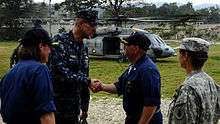United States Fourth Fleet
| United States Fourth Fleet | |
|---|---|
 | |
| Active |
1943–1950 2008–present |
| Country | United States of America |
| Branch | United States Navy |
| Type | Fleet Command |
| Role | Direct Fleet Operations |
| Part of |
U.S. Naval Forces Southern Command U.S. Southern Command (USSOUTHCOM) |
| Garrison/HQ | Naval Station Mayport |
| Commanders | |
| Current commander | Rear Admiral Sean S. Buck |
The U.S. Fourth Fleet is a United States Navy command operating the Navy component command of U.S. Southern Command (USSOUTHCOM). The Fourth Fleet is headquartered on Naval Station Mayport in Jacksonville, Florida and is responsible for U.S. Navy ships, aircraft and submarines operating in the Caribbean, and the Atlantic and Pacific Oceans around Central and South America.
First established in 1943, Fourth Fleet was a major U.S. Navy command in the South Atlantic Ocean during World War II. It was created to protect the U.S. against Axis surface raiders, blockade runners, and submarines. In 1950, the Fourth Fleet was disestablished and its responsibilities given to the United States Second Fleet.
On 24 April 2008, Chief of Naval Operations (CNO) Admiral Gary Roughead announced the reestablishment of the Fourth Fleet. The surprise announcement drew expressions of concern from some Latin American governments. The governments of Argentina and Brazil made formal inquiries as to the fleet's mission in the region. In Venezuela, President Hugo Chávez accused the United States of attempting to frighten the people of South America by reactivating the fleet[1] and vowed that his country's new Sukhoi Su-30 jets could sink any U.S. ships invading Venezuelan waters. Cuban ex-president Fidel Castro warned that it could lead to more incidents such as the 2008 Andean diplomatic crisis.[2]
On 12 July, the fleet was re-established in a ceremony at Naval Station Mayport, Florida.[3]
Mission
U.S. Naval Forces Southern Command (USNAVSO) and the Fourth Fleet support USSOUTHCOM joint and combined full-spectrum military operations by providing principally sea-based forward presence to ensure freedom of maneuver in the maritime domain, to foster and sustain cooperative relationships with international partners, and to fully exploit the sea as maneuver space in order to enhance regional security and promote peace, stability, and prosperity in the Caribbean, Central American, and South American regions. It has five missions: support for peacekeeping, humanitarian assistance, disaster relief, traditional maritime exercises, and counterdrug support operations.
Organization

Commander, USNAVSO (COMUSNAVSO) also serves as the Navy component commander for USSOUTHCOM. U.S. Fourth Fleet is responsible for U.S. Navy ships, aircraft and submarines operating in the USSOUTHCOM area of responsibility, which encompasses the Caribbean, Central America, South America, and surrounding waters. It is an organizational fleet staffed to fulfill a planning and coordination mission; as part of its 2008 reestablishment, no vessels are permanently assigned to the Fourth Fleet. Ships home-ported in the United States Fleet Forces Command and United States Third Fleet routinely deploy to the Fourth Fleet area of responsibility (AOR), during which time they are under the operational control of the Fourth Fleet commander.
Fourth Fleet headquarters is co-located with USNAVSO headquarters in Mayport, Florida, and is commanded by a two-star rear admiral .
Fourth Fleet Commanders
- Vice Admiral Jonas H. Ingram (September 1942 – 11 November 1944)[4]
- Vice Admiral William R. Munroe (11 November 1944 – 15 April 1945)[5]
- Vice Admiral Thomas R. Cooley (1945 – mid 1946)[6]
- Vice Admiral Daniel E. Barbey (September 1946 – March 1947)[7]
- Vice Admiral Charles McMorris (mid-1947 – July 1948)
- Rear Admiral Joseph D. Kernan (1 July 2008 – 12 June 2009)[8]
- Rear Admiral Victor G. Guillory (12 June 2009 – 5 August 2011)[9]
- Rear Admiral Kurt W. Tidd (5 August 2011 – 22 June 2012)[10]
- Rear Admiral Sinclair M. Harris (22 June 2012 – 17 April 2014)[11]
- Rear Admiral George W. Ballance (17 April 2014 – 12 August 2016)[12]
- Rear Admiral Sean S. Buck (12 August 2016 – present)[13]
See also
References
- ↑ "Chavez attacks the Fourth Fleet at the start of parade / Chávez arremete contra la IV Flota en el inicio del desfile militar". www.noticias24.com. 5 July 2008.
- ↑ "Fourth Fleet to intervene to Latin America tomorrow / IV Flota de intervención hacia Latinoamérica mañana". www.rlp.com.ni. 30 June 2008.
- ↑ "Navy Reestablishes U.S. Fourth Fleet". United States Navy. 24 April 2008.
- ↑ "HyperWar The Official Chronology of the U.S. Navy in World War II". United States Navy. 1 June 2006.
- ↑ "HyperWar The Official Chronology of the U.S. Navy in World War II". United States Navy. 5 June 2012.
- ↑ "Biography of Thomas Ross Cooley". United States Navy. 1 June 2006.
- ↑ "Papers of Vice Admiral Daniel E. Barbey, 1941–1969". Naval Historical Center. 1 June 2006.
- ↑ "Biography of Joseph D. Kernan". United States Navy. 5 June 2012.
- ↑ "Biography of Victor G. Guillory". United States Navy. 5 June 2012.
- ↑ "Biography of Kurt W. Tidd". United States Navy. 5 June 2012.
- ↑ "Biography of Sinclair M. Harris". United States Navy. 22 June 2012.
- ↑ "Biography of George W. Ballance". United States Navy. 24 April 2014.
- ↑ "Biography of Sean S. Buck". United States Navy. 14 August 2016.
Suggested reading
Karen Domabyl Smith; et al. (January 2002). "Is NAVSO Organized and Staff To Do Its Job" (PDF). Alexandria, Virginia: Center for Naval Analyses. Retrieved 3 September 2011. CRM D0005057.A1/Final
